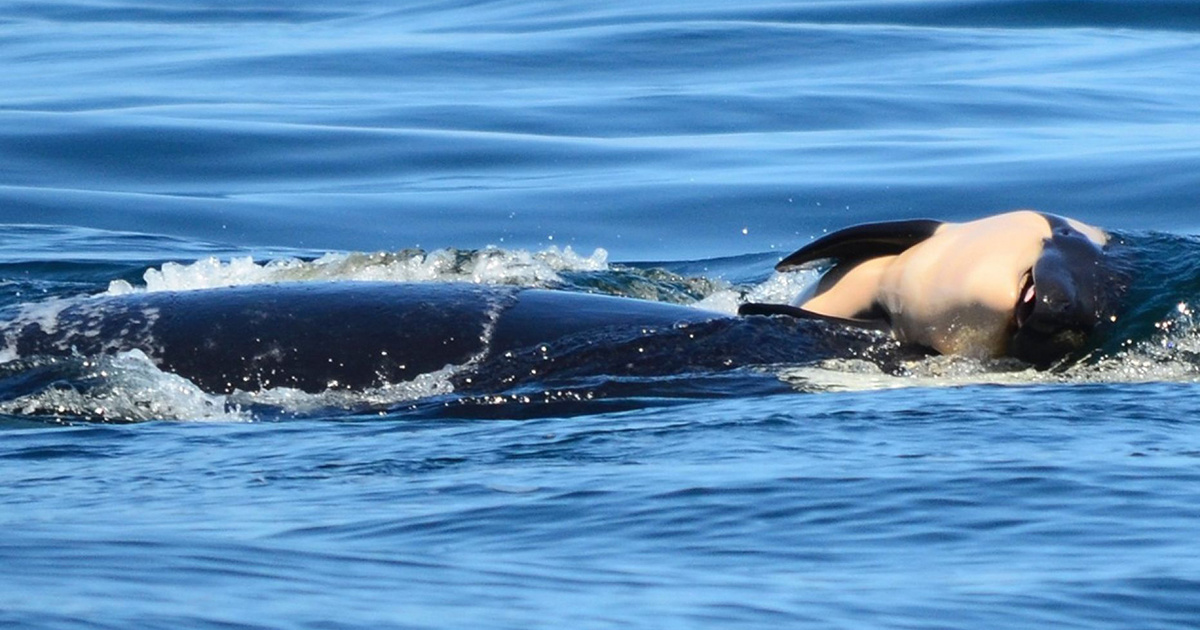

An endangered southern resident killer whale known as Tahlequah or J35, has carried her dead calf for an eighth day in a row as of Tuesday. Center for Whale Research
She hasn’t let go. An
endangered southern resident killer whale known as Tahlequah or J35, has carried her dead calf for an eighth day in a row as of Tuesday, the Seattle Times reported.
Researchers scanned the waters all day before the mother orca and her deceased newborn turned up near British Columbia’s Southern Gulf Islands.
“I am relieved we see her, that she is healthy and swimming strongly, and that she is with her family,” Taylor Shedd of Soundwatch, which has been monitoring the pod, told the publication. “But it is so emotional that she is so caring. It boggles my mind. To carry it is hard for her physically and mentally. It is just heartbreaking.”
The baby whale was born near Victoria, British Columbia on July 24. The newborn was seen alive and swimming with its mother, Tahlequah, and other members of its pod near Clover Point on the Victoria shoreline in the mid-morning but died a short time after, according to the Washington-based Center for Whale Research.
“The baby’s carcass was sinking and being repeatedly retrieved by the mother who was supporting it on her forehead and pushing it in choppy seas toward San Juan Island, USA,” the center said in a
press release. “The mother continued supporting and pushing the dead baby whale throughout the day until at least sunset.”
It’s not unusual for orcas to carry their dead offspring for about a day or so, researchers told
NPR. However, Jenny Atkinson, executive director of The Whale Museum on San Juan Island, noted this is the longest period researchers have observed.
Researchers are also concerned about Tahlequah’s health.
“I am so terrified for her well-being,” Deborah Giles, a research scientist for University of Washington Center for Conservation Biology and research director for nonprofit Wild Orca, told
The Seattle Times. “She is a 20-year-old breeding-age female, and we need her.”
The story of the “grieving” orca mother has captured international attention as the population of southern resident killer whales fights to survive.
In June, the Center for Whale Research reported that a 23-year-old male orca was missing and presumed dead, leaving the community of orcas with just 75 individuals remaining.
The population grew 48 percent to a high of 98 in 1995, but has since fallen to their lowest number in 30 years.
Experts say their decline is due to pollution, underwater noise and disturbances from boat traffic, and lack of their favored prey,
Chinook salmon. Recent deaths, particularly among calves, mothers and pregnant whales, appear to be driven by food scarcity, according to the Center for Whale Research.
“The larger environmental question reflected in the J35 story is that both the USA and Canada MUST redouble efforts to restore wild salmon (particularly Chinook) throughout Washington State and British Columbia for a food supply for the SRKW in this region,” the center
tweeted last week, citing a statement from founder and senior scientist Ken Balcomb.
The larger environmental question reflected in the J35 story is that both the USA and Canada MUST redouble efforts to restore wild salmon (particularly Chinook) throughout Washington State and British Columbia for a food supply for the SRKW in this region. – Ken Balcomb pic.twitter.com/mqQy83KxSe
— Whale Research (@CWROrcas) July 27, 2018
Earlier this year, Washington Gov. Jay Inslee signed an executive order to aid the species’ recovery and the Chinook salmon they eat.
“The diets of southern resident orcas consist largely of Chinook salmon, but the Chinook are listed on federal and state endangered species lists,” Inslee’s office
stated. “If the Chinook population continues to decline, the southern resident orca population will follow.”
Orca Whale 'Crewser' Presumed Dead as Population Reaches Its Lowest Point Since 1984 https://t.co/DnswjvwhXG#SeaShepherd #orca #whale #ocean #conservation
— Sea Shepherd US (@SeaShepherdSSCS) June 19, 2018

 233k
233k  41k
41k  Subscribe
Subscribe 